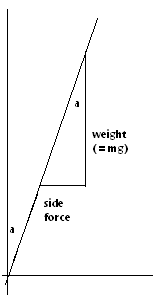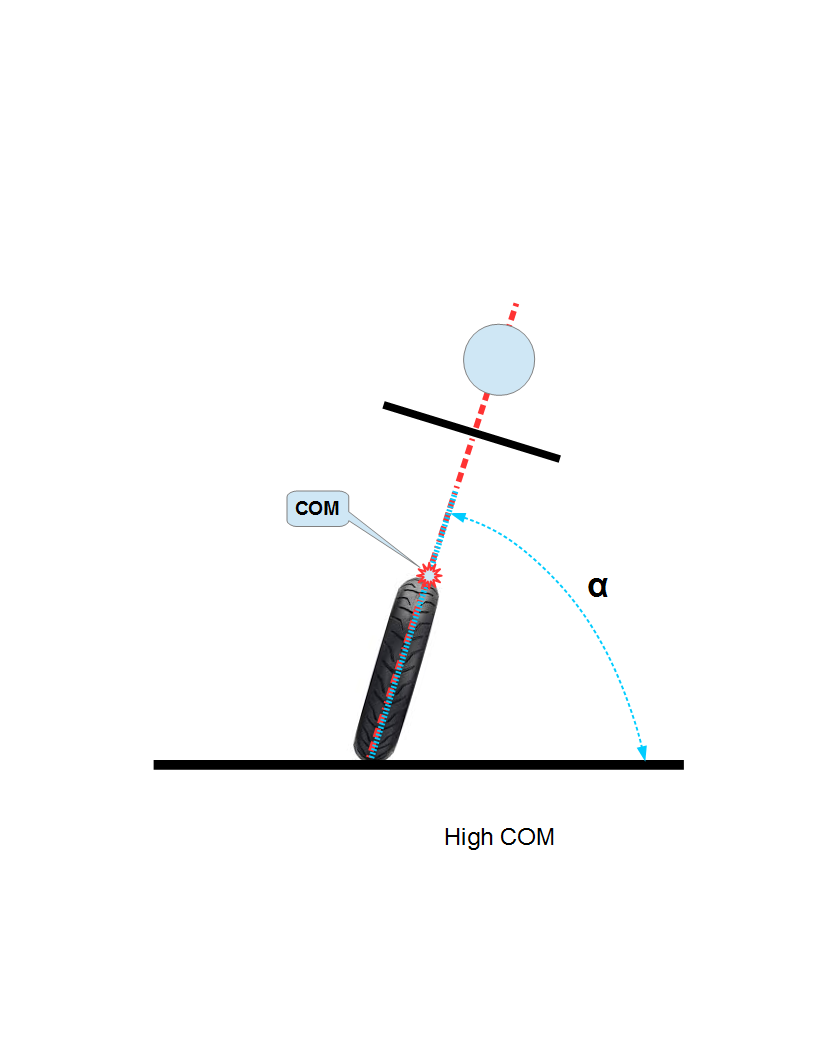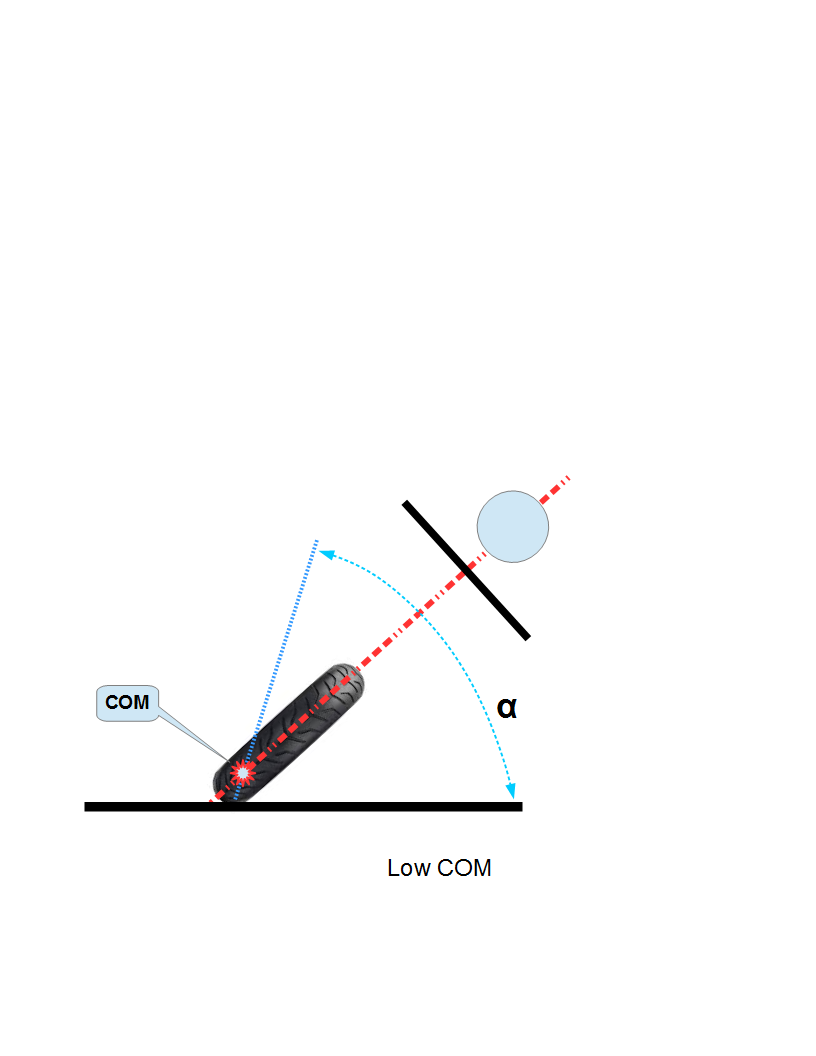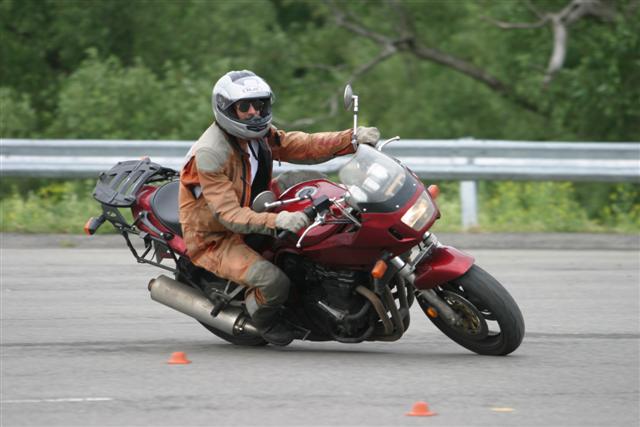Cornering Forces and Friction
Here's a question that seems more applicable than the usual high-school physics problem in ballistics, where you throw rocks at certain angles while neglecting air resistance: How fast can you drive a car around a turn before you lose traction and slide out?
This obviously depends on how fast you're going, how tightly you're turning, and the traction you have. You can make a turn at 100mph as long as the turn is gentle and you have good tires and pavement. If the turn's tighter, or you're on ice rather than clean dry pavement, the maximum speed goes down. So those three items are the variables we'll have to analyze. I'll get an expression for the side force, and another for the force of friction which has to oppose that side force to keep the vehicle on the road. Equating the two will provide an equation relating turning radius and speed.
Side Force
First let's figure out the side force on the vehicle. For a vehicle at a velocity v making a turn of radius r, the radial (that is, inward) acceleration is v2/r, the square of the speed divided by the radius. (Look that up in your physics book if you want to know how to derive it.) And since force = mass times acceleration, the side force is mv2/r, mass of the vehicle times the square of speed divided by radius of the turn.
Friction from Tires
Now the side force has to be applied by the friction of the tires on the road. The friction equation is F = μN, friction equals μ (the Greek letter mu, pronounced "myoo"), the coefficient of friction, times N, the weight of the vehicle. (Again, consult your physics text or see my explanation of friction.) The weight can be made more precise: It's the mass times the gravitational force, which is usually written "g". So F = μ*m*g.
Side Force Equals Friction
Now to put our two equations together: For a car traveling at a speed v
around a turn of radius r, the side force is mv2/r; and the frictional force
available to prevent sliding is μmg. At the point of maximum turning force,
where the traction provided by the tires is at its limit, those two forces
must be equal:
mv2/r = μmg
Conveniently, the mass appears on both sides of the equation, so we can
cancel it:
v2/r = μg
Rearrange this to
v2 = μgr
Adjust the Units for Convenience
The units of speed, radius, and gravity need to be consistent. For us
colonials, speed is most conveniently measured in miles per hour, and radius
in feet. If you do the arithmetic you'll find that miles per hour times 1.47
gives you feet per second. g in English units is 32.2 feet per second per
second. So plugging those numbers into the equation we get
(1.47v)2 = 32.2μr
which reduces to
v2 = 14.9μr
where the speed v is in miles per hour and the radius r is in feet. (Those
of you who live in a place with sensible units can use
v2 = 127μr
where speed is in kilometers per hour and radius is in meters.)
Coefficient of Friction
The final piece of that equation to think about is μ, the coefficient of friction. Getting a sensible value for μ is unexpectedly difficult. For one thing, the force required to start sliding is greater than that required to continue sliding. And if one surface is rolling on the other, as would be the case in a tire rolling on the road, the force required to start sliding is somewhere between the static and dynamic cases. But checking the CRC Handbook of Chemistry and Physics I found values of static friction for rubber on clean asphalt and concrete to be close to 1. I'll run the numbers with that value, and also the more conservative value of .65, to account for the decreased coefficient of friction when the tire is rolling. (But see the end of this page for a possible source of values for μ.)
So, How Fast Already?
Suppose you're on a residential road, about 25 feet across, approaching an intersection with a similar road, intending to turn left. How fast could you take the turn? The radius of the turn will be 25 feet (assuming you're staying near the right-hand edge of the road, at the maximum width). Using the optimistic value of 1 for μ, the coefficient of friction, we havev2 = 14.9*25, so
v = 19.3 miles per hour. If the coefficient of rolling friction is less than 1, say .65, we get
v2 = 14.9*.65*25 so
v = 15.6 miles per hour.
A 25-foot radius is a pretty tight turn. Let's see how tightly you could turn
at 60mph. Using μ=1
602 = 14.9r and solving for r we get about 240 feet. That increases to about
370 feet if μ=.65.
No, you can't go that fast!
It is important to realize that the speed thus calculated is an upper limit. It is the speed at which the tires begin to slide, the speed which a top-rated racer would approach in a hotly-contested race; the speed at which an ordinary person would go just before he crashes; the speed that the cop would write up as reckless operation.Furthermore, realize that any imperfections in the road would reduce the friction and cause anyone at that speed to slide: a clump of leaves, a little sand, a painted line, a fuel spill from the overfilled car with no fuel cap. Normal people on public roads (and the cops) would be a lot happier at half or 2/3 that speed, to leave some safety margin.
Noam Ben-hamou took the above as a starting point and greatly extended it. At his site you can use google maps to specify a road and a level of aggressiveness to see how quickly it can be run. (Keep in mind that the cops will not be as interested in this as you may be.)
Science Project!
This suggests a way for an enterprising group of young people to make a solid contribution to the usefulness of the Web: You can use the equation v2 = 14.9μr to measure the coefficient of friction. Find a large, lightly-used parking lot and mark a circle with a radius of say 50 feet. Make sure there's nothing to hit when you slide. (Normal passenger cars won't flip when they slide; I wouldn't do this with a SUV.) Start driving around the circle, keeping the circle between the car's tires, and gradually increase the speed until the car slides. Probably best to have a passenger sitting in the back seat behind the driver to watch the speed so the driver can concentrate on maintaining a smooth path. Note the speed when the car slides. Plug the speed and radius into the equation, solve for μ.
For example, suppose you start to slide at 25mph. v = 25, r = 50, gives a value for μ of about .8. Try it again in the rain, and again when it snows. And — now pay attention, this is most important — don't tell the cops that I told you to do it! (But do report your results to me afterwards.)
If You Did That On A Motorcycle, How Much Would It Lean?
We've done most of the work to figure out lean angle on a bicycle or
motorcycle. If we can relate the side force on a motorcycle to the lean
angle, we'll have it.
 |
The diagonal line represents a motorcycle leaned at an angle from
the vertical. The two angles labeled "a" are the same (they're alternate
interior angles to the two vertical lines). The line labeled "weight" is
of course the weight of the motorcycle and rider, always directed straight
downwards. From our basic trigonometry we know the hypotenuse of the
right triangle is the length of the vertical side (which is mg) divided
by the cosine of the angle a, h = mg/cosa and the horizontal line, the side force, is the hypotenuse times sina: F = mgsina/cosa = mgtana |
That is, side force is mass times gravity times the tangent of the lean angle a (measured from the vertical).
Now recall from above that the side force is also mv2/r, so we have:
mv2/r = mgtana
Again we can cancel the mass, leaving
v2/r = gtana
and move the gravitational constant g to the other side:
v2/rg = tana
Now again we need to make the units consistent, so converting v in mph to
fps we have
(1.47v)2/rg = tana
2.16v2/rg = tana
and plugging in g=32.2 we get finally
.067v2/r = tana
So there's our equation. For instance, if you're driving a motorcycle
around a turn with a 200-foot radius at 45mph, we have:
tana = .067*452/200
tana = .67948, and using the inverse tangent function on my calculator I get
x = 34 degrees.
What's the real lean angle?
The concept of the lean angle is not as trivial as one would imagine. If we had infinitely thin tires then it'd be obvious: Just draw a line from the center of mass to the contact point and measure the angle between that line and the horizontal or vertical. But we have fat tires. The actual lean angle must be measured from the center of mass to the center of the contact area, which will be to the inside of the tire. So the apparent lean angle — using a line parallel to the forks, say — will be greater than the actual lean angle, using the center of the contact area of the tire. Note that this means that a motorcycle with a lower center of mass will lean more than a motorcycle with a higher center of mass, for a given corner radius and speed. |
 |
Lean Angle and Coefficient of Friction
There's an interesting relationship between the lean angle of a motorcycle and the coefficient of friction of the tires. We just figured out that the tangent of the lean angle is equal to v2/rg. Back in the section "Side Force Equals Friction" we figured out that v2/rg = μ, the coefficient of friction. So we can conclude that the coefficient of friction is equal to the tangent of the maximum lean angle!
We can see this in another way as well. In this section, we concluded that
F = mgtana, where mg, the mass times the gravitational constant, is just the
downward force of the motorcycle, due to its weight. But we also know that
the force of friction between two surfaces is equal to the force pressing
those surfaces together — the weight in this case, mg — times the
coefficient of friction. So we have
F = mgtana = mgμ, which reduces to
tana = μ.
Sometimes the motorcycle tire makers will give a maximum lean angle for
a particular tire. For instance, in May 2009
Michelin claims a maximum lean
angle of 50.6 degrees on dry pavement and 41.9 degrees on wet pavement "as
measured at the Michelin test track" for their Pilot Power sportbike tires.
One might guess that the Michelin test
track's pavement has less sand and better maintenance than standard street
pavement, but that's purely a guess. In any case, that gives a coefficient
of friction of 1.2 on dry pavement and .90 on wet pavement.
BMW's S1000RR sportbike has a traction-control mechanism which measures lean
angle and restricts power when the angle exceeds a predetermined limit. Rain
mode allows 38 degrees of lean, corresponding to a coefficient of friction of
.78; sport mode allows 45 degrees, μ = 1; race mode allows 48 degrees,
μ = 1.1; and slick mode gives 53 degrees, μ = 1.3
Braking and Coefficient of Friction
As long as we're at it, we can use shortest braking distance to arrive at a lower bound for the coefficient of friction. Motorcycle Consumer News provides minimum braking distance from 60mph to 0 for many of their motorcycle tests. The best braking distances are in the 105-foot range from that speed. So dust off your copy of Halliday and Resnick or other physics text and find the equation for acceleration given the starting speed v0 (60mph = 88fps in our case), ending speed vx (zero), starting distance x0 (zero), ending distance x (105 feet):vx2 = v02 + 2a(x - x0)
Substituting the values we have
0 = 882 + 2a105
and solving for a, the acceleration, we get
a = -36.9 feet per second per second. (The fact that the acceleration is negative means that we're decelerating.)
Now on the page Can you brake faster than cars? I derive the equation
a = μg, where g is the acceleration of gravity, 32.2 feet per second per second, and a is deceleration due to braking. So we have
36.9 = μ times 32.2, and solving for μ we get
μ = 1.15. So the coefficient of friction for that tire on that pavement has to be at least 1.15.
